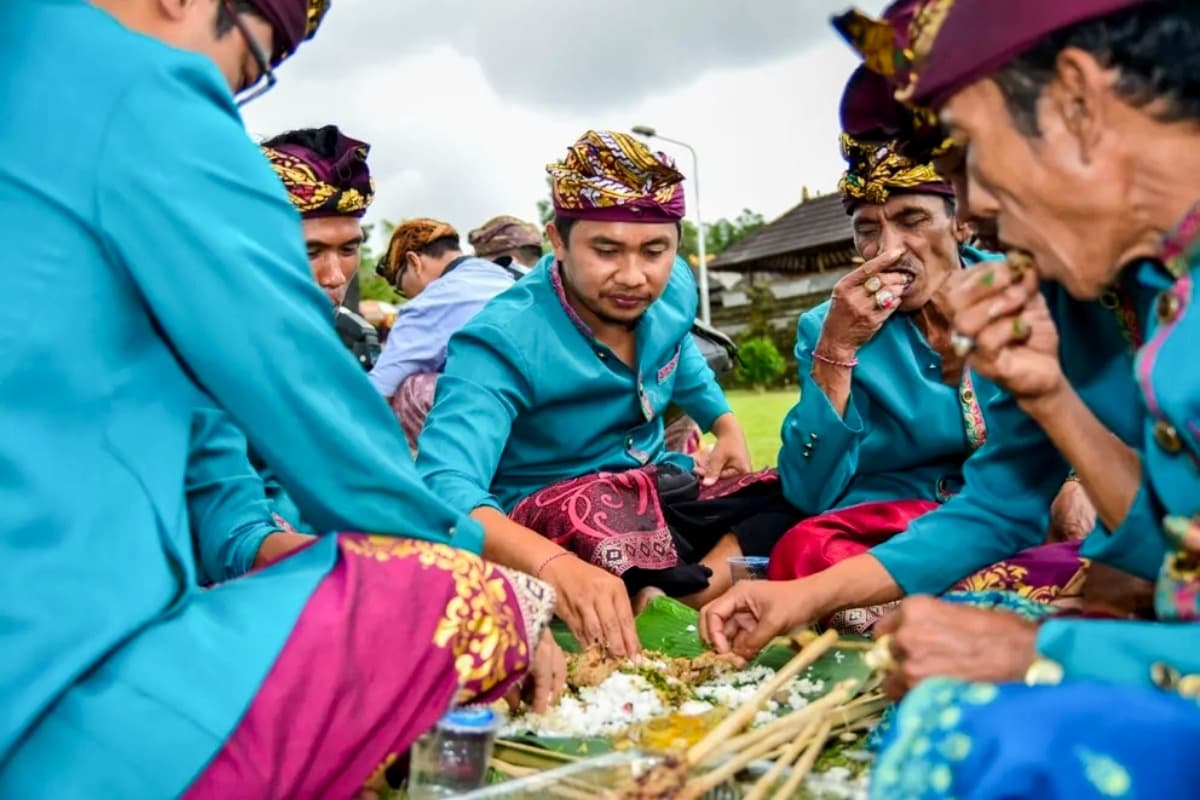
Balinese people have many unique and sacred rituals, including one centered around food and community. This tradition is called Megibung, which means eating together from a shared plate as a symbol of solidarity, equality, and kinship among participants.
The tradition is an ancient ceremonial practice, most closely associated with the Karangasem Regency, but today it’s celebrated across the island. This article will help you understand what Megibung is, its history, philosophy, and how you can experience this authentic communal dining ritual firsthand, a true reflection of Bali’s warmth and togetherness.
What is Megibung? Understanding the Basics
Megibung involves a group of four to eight people sitting cross-legged on the floor, sharing food piled high on a large tray lined with banana leaves. Everyone eats simultaneously, using only their right hand, a gesture that promotes unity and humility.
The term megibung in English roughly translates to “communal eating” or “eating together,” symbolizing solidarity and equality. Traditionally, this Bali dining traditions reflects a spirit of camaraderie, especially before or after war.
The food arrangement, called gibungan, features local dishes such as lawar, babi guling (suckling pig), sate lilit, and other flavorful Balinese foods, creating a true feast of flavors and harmony.
The Historical Roots of Megibung Tradition
The Megibung ceremony originated in Karangasem, East Bali, during the reign of King I Gusti Anglurah Ketut Karangasem around 1692. After returning victorious from a military campaign in Lombok, the King instructed his soldiers to eat from a single plate to symbolize unity and strengthen bonds between ranks.
Since then, Megibung Bali has become a symbol of equality and gratitude, carried out during major ceremonies such as temple festivals, weddings, and Balinese holidays like Galungan, Kuningan, and Nyepi.
The Cultural Significance and Philosophy Behind Megibung
At its core, the Megibung tradition celebrates giving, sharing, and gratitude. It embodies several essential Balinese philosophies:
- Unity (Menyama Braya): Sharing one dish reinforces the belief that all are equal, fostering kinship beyond blood relations.
- Equality: Regardless of rank or wealth, everyone is treated equally. Even kings once joined their people in the ceremony, symbolizing humility and respect.
- Gratitude: Each meal is a form of thanksgiving for both nourishment and companionship, ensuring that no one is left hungry during the ritual.
What Food is Served During Megibung?
The dishes served during Megibung Bali are a celebration of flavor and community, representing the island’s diverse culinary heritage:
- Rice: Usually placed in the center, either plain white or nasi kuning (turmeric rice).
- Meats: Favorites include ayam betutu (slow-cooked spiced chicken), sate lilit, babi guling, roasted duck, and lawar.
- Veggies: Local greens like cassava leaves, spinach, and sambal (spicy relish) add freshness and balance.
This communal spread transforms Megibung into a royal dining experience, a tradition once reserved for kings and warriors.
Megibung Etiquette: Rules and Traditions to Follow
To join a Megibung ceremony respectfully, keep these customs in mind:
- Use the Right Hand
Always eat with your right hand, as the left is considered impolite. Wash thoroughly before joining the meal. - Stay in Your Area
Take food only from the section in front of you, and avoid reaching across others, as it is considered impolite. - Avoid Waste
Take small portions first and finish what you take before reaching for more. In Balinese culture, leaving food unfinished is considered disrespectful, as it implies the food is not good. - Mind Your Manners
Speak politely and avoid talking while chewing to show respect for others. You may speak when requesting an additional portion of food.
Experience Authentic Megibung at Ankhusa Restaurant Ubud
While primarily a cultural ceremony, many luxurious establishments now offer this tradition as a fine dining option, transforming it into a sophisticated royal dining experience for guests. One such place is Ankhusa Restaurant Ubud, which proudly features the Megibung tradition on its menu.
Ankhusa presents communal dishes made with high-quality ingredients and elegant presentation, allowing travelers to experience the true essence of Balinese togetherness in a refined and comfortable setting. There are three menu options available at Ankhusa:
- Megibung Ulam Segara
Offers exquisite seafood dishes inspired by traditional Balinese recipes, including squid satay, grilled prawns, clams, and sate lilit made from fish. - Megibung Bali Dwipa
Represents the island’s diverse culinary traditions with dishes such as pork belly and sate lilit pork seasoned with authentic Balinese spices. - Megibung Perayuan Raja Bali
A royal-style gibungan featuring slow-roasted beef infused with base genep (Balinese traditional spices), complemented by beef sate lilit and jukut ares (banana stem soup).
Conclusion
The Megibung tradition stands as one of Bali’s most profound symbols of unity, gratitude, and equality, a ritual that transforms sharing a meal into a celebration of community. Participating in Bali’s dining tradition will offers travelers an unforgettable cultural experience that reveals the soul of the island through its food and fellowship.To explore more about Balinese culture, and dining experiences ideal for couples, families, and groups, visit The Wonderspace and plan your next authentic Bali adventure.

